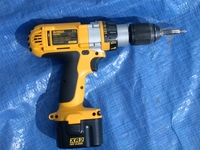
The power drill is one of the most commonly used power tools in the workplace. Using this otherwise simple tool, workers can drill pilot holes into wood or other materials with ease. But like all power tools, there's an inherit risk of injury when operating a drill. If your job requires you to use a power drill on a regular basis, follow the safety tips outlined below to reduce your risk of injury.
According to an article published by Forbes, there were approximately 5,800 injuries that required hospital emergency room treatment attributed to power drills in 2007. Granted, that number is significantly lower than nail guns, but it's still a serious problem when thousands of workers are sent to the ER room each year for such injuries.
Personal Protective Equipment
The first step in safely operating a power drill is to acquire the appropriate personal protective equipment (PPE). This includes impact-resistant goggles or eyewear, as well as gloves. Ear protection typically isn't needed unless there's some other type of noise-producing machine or equipment being used. Standard power drills rarely produce enough noise to harm your hearing.
Avoid Baggy Clothes
When operating a power drill, a good rule of thumb is to wear tight-fitted clothes with no jewelery or accessories. It's not uncommon for workers to get their shirt sleeve stuck in the drill, causing the bit to go into their skin. This is easily avoided, however, by wearing non-baggy clothes. If you are wearing a watch, bracelet or other jewelry that could get in the way of the bit, go ahead and remove it.
Drill a Pilot Hole
I know this probably sounds like common sense, but it's easier (and safer) to drill a screw into wood by first drilling a pilot hole. The pilot hole acts to guide the screw, reducing the risk of the drill accidentally kicking back towards your body.
Inspect Your Power Drill
If it's been a while since you've used a power drill, inspect it and the cables for damage before operating it. If the head is loose and/or damaged, avoid using it, as this may cause further damage to the drill or injury to you. You can refer to your power drill's user manual for more information about its specific components and how to repair it.
Use Moderate Pressure
Don't try to manhandle your power drill. In most cases, it should only take a small amount of pressure to force the bit into the pilot hole. If you press your entire body weight against the drill, you may slip and fall towards the bit, which of course may cause serious injury.
